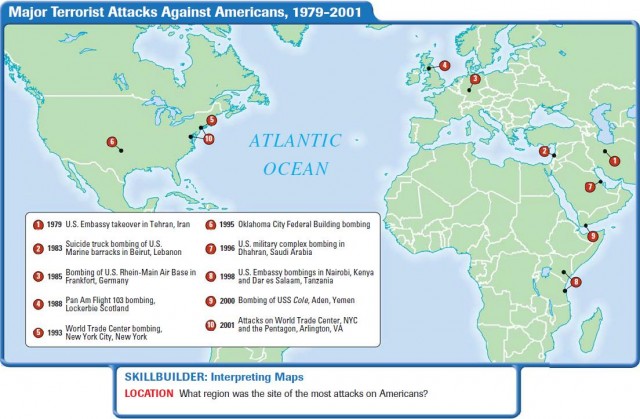The Fight Against Terrorism
A HUMAN PERSPECTIVE For Karl Co, a 15-year-old sophomore at Stuyvesant High School in New York City, September 11, 2001, began as “such a normal day.” From his classroom, Karl had a clear view of the World Trade Center, just four blocks away. On a normal day, about 50,000 people worked in and 70,000 visited the twin towers. When the north tower burst into flames and smoke, Karl first thought, “It's a bomb. I'm going to die.” Then the south tower erupted, and, shortly after, both collapsed. The students soon learned terrorists had crashed airliners into the towers, and the school was evacuated.
The September 11 Attacks
The students at Stuyvesant High had witnessed an act of terrorism. Terrorism is the unlawful use of, or threatened use of, force or violence against individuals or property for the purpose of intimidating or causing fear for political or social ends. Like many countries, the United States has been subjected to terrorism, both at home and abroad. But the September 11, 2001, attacks were the most destructive acts of terrorism ever committed on American soil.
On that morning, 19 Arab terrorists hijacked four airliners. They crashed two planes into the World Trade Center towers and one into the Pentagon, the U.S. military headquarters near Washington, D.C. The fourth plane crashed in Pennsylvania without striking its intended target, after some passengers overwhelmed the hijackers.
THE DESTRUCTION
The hijacked planes were loaded with fuel. They became destructive missiles as they crashed into their targets. Thousands of workers escaped before the damaged skyscrapers collapsed. Fire and raining debris caused nearby buildings to collapse as well. At the Pentagon, the plane tore a 75-foot hole in the building's west side.
About 3,000 people died in the attacks. The dead included 265 plane passengers and 343 New York City firefighters who had entered the towers to rescue those trapped inside. Nine buildings in the city's financial district were completely destroyed or partly collapsed, and six others suffered major damage. The disaster area covered 16 acres.
THE TERRORISTS
Immediately after the attacks, investigators worked to identify both the hijackers and those who directed the attacks. The evidence pointed to a global network, or worldwide interconnected group, of extremist Islamic terrorists led by Osama bin Laden, a Saudi Arabian millionaire. The group, known as al-Qaeda, was formed to fight the Soviet invasion of Afghanistan in 1979. Al-Qaeda later began to oppose American influence in Muslim lands. It started to target Americans and U.S. allies after the Persian Gulf War in 1991. Since its founding, al-Qaeda has carried out numerous terrorist attacks.

Aftermath of the Attacks
The September 11 attacks shocked and distressed not only Americans but people around the world. President George W. Bush declared war on terrorism and called on other nations to join the United States in fighting global terrorism. He also pushed for new security measures at home and authorized a search for suspected terrorists.
INTERNATIONAL WAR ON TERRORISM
The United States organized a coalition, or an alliance, of nations to fight the war on terrorism. Canada, China, Great Britain, Pakistan, Russia, and many other nations joined the coalition. They pledged to share information, arrest terrorists in their countries, and seize the financial assets of terrorist groups. The coalition also supported military action in Afghanistan, where al-Qaeda was based. As part of Operation Enduring Freedom, the United States began bombing Afghanistan in October 2001, and later sent in ground forces. By mid-March 2002, Afghanistan's extremist Taliban regime had been removed from power and the al-Qaeda network severely weakened. In March 2003, President Bush expanded the war on terrorism by taking military action against Iraq. The President claimed that Iraqi dictator Saddam Hussein posed a threat to national security. Major combat in Iraq ended in May soon after Hussein's regime had been toppled.
HOMELAND SECURITY
New airport security measures were enacted after the September 11 attacks. In addition, extra precautions were taken at public places where large numbers of people gather, such as sports stadiums. Other possible targets—nuclear power plants and water supply systems—expanded security. The Department of Homeland Security, initially led by Secretary Tom Ridge, was established to coordinate antiterrorist efforts.
Facing Terrorist Threats
Terrorism has been a global problem for decades. The prevention of terrorist attacks is one of the most difficult tasks facing the world today.
TERRORIST OPERATIONS AND WEAPONS
Terrorists act in secret and can move from country to country while pursuing their objectives. Some terrorist groups want territory, like Palestinian extremists who use violence trying to gain a homeland in Southwest Asia. Other terrorists, such as the domestic terrorists who bombed the Federal Building in Oklahoma City in 1995, want to attack government policies.
Terrorists can use other weapons besides bombs and fuel-laden planes, including biological, chemical, and nuclear weapons. Biological weapons refer to bacteria and viruses that can be used to harm or kill people, animals, or plants. The United States went on an anthrax alert after traces of the anthrax bacteria were found in letters sent to some members of Congress and the news media after the September attacks.
BALANCING SECURITY AND FREEDOM
The United States and its allies hope to reduce terrorism by breaking up terrorist groups and by increasing security to make it harder for terrorists to act. But there are many kinds of terrorist threats, and the fight against global terrorism could go on for many years. Democratic countries also have to meet the challenge of providing security for citizens while preserving freedom and individual rights.